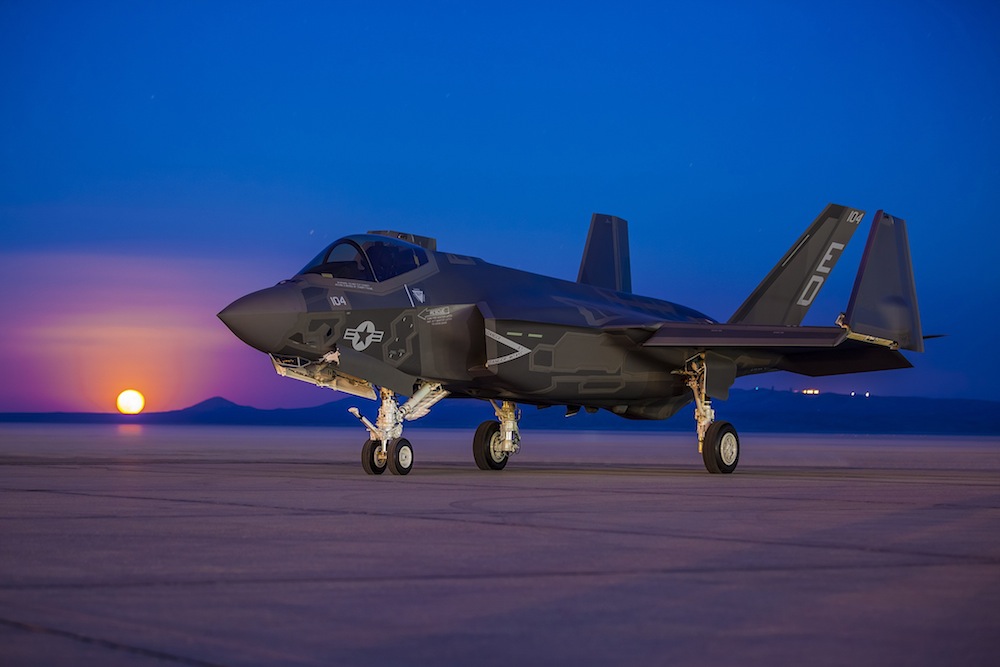F-35 Fighter Jets Won't Make Overseas Air-Show Debut

The current state of the U.S. military's F-35 fighter-jet program is a mixed bag. The good news is that the fleet — which has been grounded since July 3 after one of the planes caught fire — has been cleared for limited takeoff. The bad news is that the planes won't be making their overseas debut at this year's Farnborough International Airshow in the United Kingdom.
Although the next-generation fighter jets can return to the skies, they're subject to flight restrictions that prevent them from crossing the Atlantic Ocean to attend the air show, Navy Rear Adm. John Kirby, the Pentagon's press secretary, said at a news conference on July 15.
The United States' entire fleet of F-35 Joint Strike Fighters was recently grounded after one of the warplanes caught fire on a runway at Eglin Air Force Base in Florida. The incident, which resulted in more than $2 million worth of damage to the affected plane, was the latest in a series of setbacks for the Air Force's newest fighter jet. [Supersonic! The 10 Fastest Military Airplanes]
Several F-35s were slated to be showcased at Farnborough, as well as the annual Royal International Air Tattoo, the world's largest military air show, which was held July 11 to 13 in Gloucestershire in the U.K. The events would have marked the jets' international air-show debut.
"While we're disappointed that we're not going to be able to participate in the air show, we remain fully committed to the program itself and look forward to future opportunities to showcase its capabilities to allies and to partners," Kirby said.
Kirby said the decision to not send the jets overseas was reached after consulting with senior military leaders and aviation authorities. Until further notice, F-35 pilots are limited to a maximum speed of Mach 0.9, which is about 685 mph (1,100 km/h). After 3 hours of flight time, each front fan section of the plane's engine will also need to be inspected with a borescope, an optical instrument used to examine the inside of engines.
Earlier this week, Kirby said the 3-hour flight restriction represents a "pretty significant limitation" for planes trying to cross the Atlantic Ocean. But despite the disappointing news, Kirby said he remains confident in the F-35 program.
Get the world’s most fascinating discoveries delivered straight to your inbox.
"New programs often go through these kinds of challenges," he said. "We're confident that we're going to get through this."
Kirby didn't provide details about what might have caused the June 23 engine fire at Eglin Air Force Base. However, when speaking at the Brookings Institution, a Washington, D.C.-based think tank, on Tuesday (July 15), Gen. James Amos, the commandant of the U.S. Marine Corps, said that the engine fire that caused the fleet's grounding was probably a "one-off" incident.
Amos said military authorities — as well as engineers for the planes' manufacturers, Pratt & Whitney and Lockheed Martin — have inspected approximately 96 F-35 planes and their engines. All but three of the jets had cleared the inspection as of Monday night (July 14), Amos said. But the investigation into what caused the fire is still ongoing.
"We know what happened," Amos said. "We're just not quite sure why it happened."
At Farnborough on July 13, Lt. Gen. Chris Bogdan, head of the F-35 program, told reporters that a total of 98 Pratt & Whitney F135 engines had been inspected by military and defense contractor engineers, and that none of the other engines were found to have the same issue as the engine that failed in June.
That "issue" is a damaged turbine blade within the engine, Reuters reported. Defense Undersecretary Frank Kendall, the Pentagon's chief weapons buyer, who was also present at Farnborough on July 13, told reporters that the engine fire was caused by "excessive" rubbing of fan blades in the engine.
The U.S. Department of Defense has not issued an official statement regarding the cause of the fire.
Follow Elizabeth Palermo on Twitter @techEpalermo, Facebook or Google+. Follow Live Science @livescience. We're also on Facebook & Google+. Original article on Live Science.


